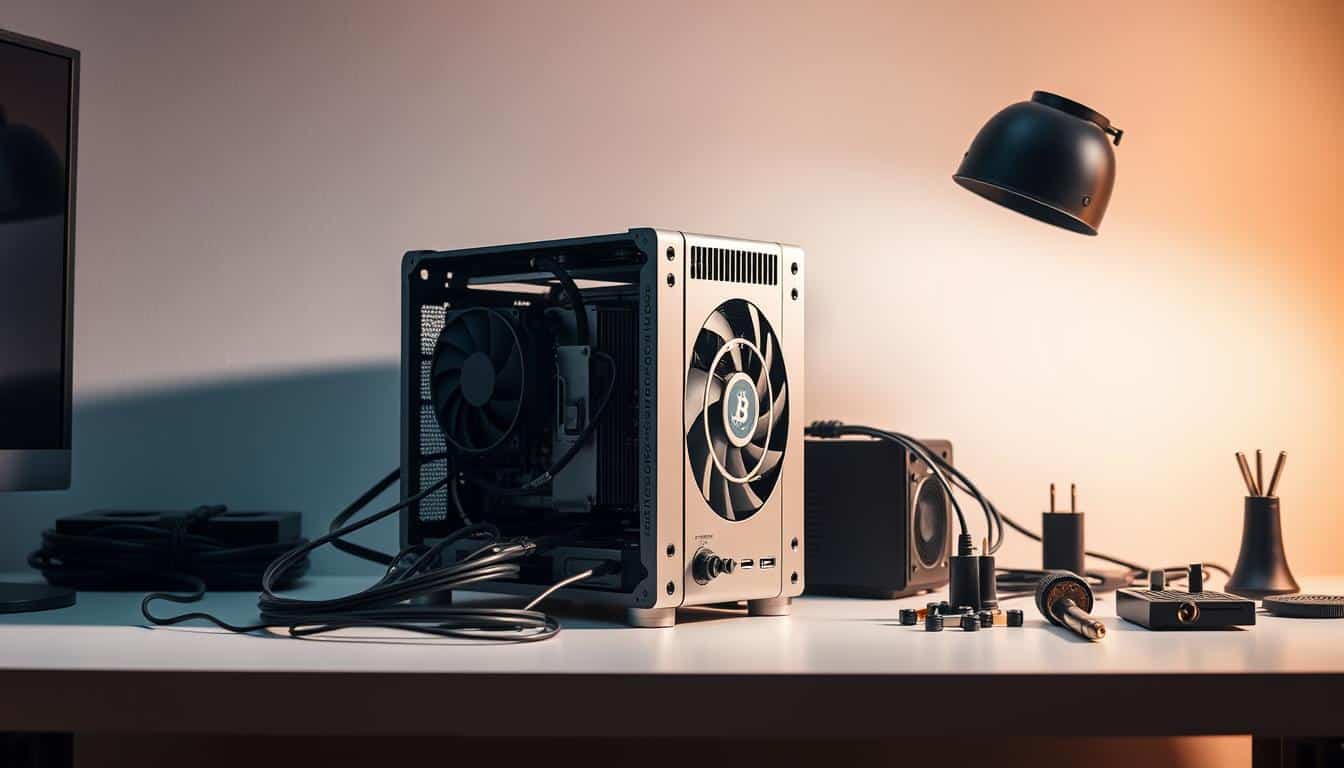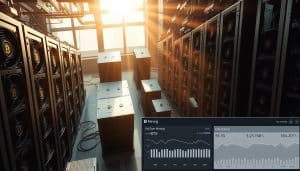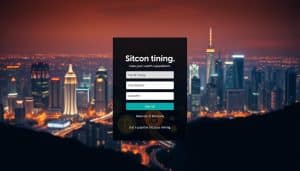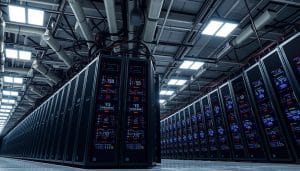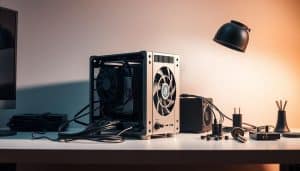I start with a punch: in 2021 miners pulled in $15 billion in revenue. That number tells you how big the market is and why efficiency matters.
I write from hands‑on work and simple tests. I frame “cheapest” around total ownership, not just sticker cost. A low‑power, reliable unit often beats a bargain box across a full cycle.
I’ll point to the exact tools I use — profitability calculators, pool dashboards, firmware, and the small software tweaks that keep a unit stable. Expect specific brand data like Antminer S21 efficiency versus mid‑tier models so you can judge tradeoffs.
Short graph ideas and a clear parts checklist will follow. I’m candid about used vs. new, noise, heat, and the first tests I run on temps and power. This guide is practical, U.S.-focused, and meant to be repeatable.
Key Takeaways
- 2021 miner revenue of $15B shows how large and competitive the scene is.
- “Cheapest” means lowest total cost of ownership, not lowest price.
- I use real tools: profitability calculators, pool dashboards, and firmware.
- Efficiency (J/TH) drives long‑term returns more than sticker cost.
- Expect tradeoffs: warranty, shipping risk, noise, and cooling needs.
What “cheapest bitcoin mining rig setup” really means in the United States today
When I compare total ownership costs, sticker price becomes only one line in a larger equation. In the U.S., you must map the purchase against taxes, shipping, wiring, and monthly power to see real value.
Efficiency trumps headline hashrate. ASICs range from about $500 to $10,000 and efficiency is measured in J/TH — lower is better. For context: Antminer S21 ≈14.2 J/TH; T21 ≈19 J/TH; Whatsminer M60 ≈19.2 J/TH; M66S Immersion ≈18.5 J/TH. Basic U.S. starter builds often run $1,300–$1,500 in 2025.
I judge buys by break-even electricity rate per J/TH, not just hashrate. A cheap unit with poor power consumption will add tens of dollars to your electric bill every month.
- Pay a bit more for mid‑teens J/TH if your residential rate is average.
- Factor delivery time and warranty — delays can eat returns if difficulty rises.
- Value is monthly cash flow after power and pool fees; run at least two calculators before deciding.
Snapshot of the market: key statistics, graph ideas, and evidence-backed context
A short data tour shows how J/TH collapsed and pushed older gear into obsolescence.
Quick evidence points: miner revenue hit $15B in 2021 and bitcoin mining holds >99% of PoW hashrate. Those facts set a tough competitive baseline for newcomers.
Graph concept
Visualize a line of J/TH over time: CPU six‑figure values in 2009 down to low double digits by 2025. Add a small bar series for cumulative efficiency gains between generations.
Compact comparative list
- CPU (2009): ~877,193 J/TH
- GPU (2009): ~264,550 J/TH
- FPGA (2011): ~43,000 J/TH
- S9 (2016): 98 J/TH → S21 (2025): ~14.2 J/TH
| Year / Model | Reported J/TH | Relative gain (%) | Why it matters |
|---|---|---|---|
| 2009 CPU | 877,193 | — | Sets the starting point for efficiency |
| 2011 FPGA | 43,000 | ~2038% | Big leap; began commercial competition |
| 2016 Antminer S9 | 98 | ~438,672% | Consumer ASIC era |
| 2025 S21 | 14.2 | ~6900% | Current efficiency baseline for new units |
Source notes: I cross‑check vendor claims against independent spec sheets for S19, S21, Whatsminer lines, and Avalon before trusting published efficiency. Big outliers usually mean measurement differences or nonstandard cooling.
Choosing the right mining rig type for cost control
Choosing a mining path starts with matching the algorithm to the device. I look first at algorithm demands, then at power and practicality. That approach keeps monthly costs predictable.
ASIC vs. GPU vs. CPU vs. FPGA: energy efficiency and practicality
Efficiency gains tell the story. GPUs beat CPUs by roughly 332% on efficiency, FPGAs improve ~615% over GPUs, and ASICs top FPGAs by about 460%.
Practical takeaway: for SHA‑256 work, ASICs win on energy and payback. CPUs are largely obsolete for Bitcoin-class algorithms.
Why ASICs dominate and where GPUs still make sense
ASICs hold over 99% of PoW hashrate for Bitcoin. That market share reflects raw J/TH advantage and scale.
GPUs remain relevant for algorithm‑resistant networks or altcoins where flexibility matters. A home computer‑based GPU frame is a good learning platform for altcoins and experimentation.
- ASICs: densest, loudest, best J/TH for SHA‑256.
- GPUs: flexible, good for Ethash/Equihash derivatives and learning.
- FPGAs: programmable middle ground; rarely beat modern ASICs on J/TH.
- CPUs: best for accessibility or CPU‑friendly coins like Monero.
| Device | Relative efficiency gain | Best use case |
|---|---|---|
| CPU | Baseline | Accessibility; CPU‑friendly coins |
| GPU | ~+332% vs CPU | Altcoin flexibility; learning and small farms |
| FPGA | ~+615% vs GPU | Specialized, low‑latency experiments |
| ASIC | ~+460% vs FPGA | SHA‑256 cash‑flow and high-efficiency Bitcoin plans |
The cheapest bitcoin mining rig setup
I learned early that a clear parts list beats shiny specs when you add up months of electricity.
Start with a compact checklist and work outward. A frame, a verified ASIC or GPUs, motherboard, CPU, RAM, an SSD, and a quality PSU are the backbone. Add PCIe risers for GPU builds and reliable cabling for any equipment.
Practical size note: modern ASICs often weigh ~11–39 lb and measure about 30–40 cm long by 15–20 cm wide and 25–30 cm high. That shapes your cooling and mounting choices.
Core components checklist: hardware, software, power, and cooling
- Lean checklist: honest-efficiency ASIC or tested GPUs, a strong PSU, and stable network.
- Mining software, a wallet, and a bootable OS — plus keyboard/mouse and a monitor for setup.
- Reuse an older SSD and spare RAM to cut initial cost without hurting hashrate.
- Keep spare fans, thermal paste, and quality surge protection on hand.
Where to economize—and where not to cut corners
Don’t skimp on risers or the PSU; most crashes trace back there. Plan for ducting or a DIY hush box if noise is an issue at home.
Step-by-step guide: from parts on the table to hashing
A tidy workspace and a stepwise plan cut setup time and errors more than any tutorial. Below I walk through a concise, battle-tested process to go from parts to a stable hash run.
Assemble: board, CPU, RAM, PSU, storage, frame
I lay the motherboard on an anti-static mat, drop the CPU in, and add a pea-sized thermal dot. Then I mount the cooler and snap in RAM modules.
Next, I screw the board to the frame, install the PSU, plug the 24-pin and the CPU 8-pin, then attach storage (SATA or NVMe) and fans.
Install and cable: risers, GPUs or ASIC power, network
Seat PCIe risers and GPUs, using dedicated 6/8-pin GPU cables—avoid SATA power chains on high-draw risers.
For an ASIC-based unit the process is simpler: secure the device, plug proper power leads, and hook the network cable.
Configure: BIOS, drivers, mining software, and pool connection
BIOS tips: set PCIe to Gen1, enable Above 4G Decoding, and disable unused controllers to avoid boot issues.
| BIOS Change | Why it helps |
|---|---|
| PCIe = Gen1 | Stabilizes riser communication |
| Above 4G Decoding | Allows multi-GPU address space |
| Disable unused SATA/HD Audio | Fewer boot conflicts |
Install a lean OS (I use Windows with telemetry off), then graphics drivers only. Add trusted mining software and point it at your chosen mining pool.
First run: monitoring temps, power draw, and hashrate
On first boot, check wall-meter power draw vs. spec and watch temps under load.
Run the unit for 30–60 minutes to verify steady hashrate and no crashes. Log values and compare them against vendor claims.
Power consumption, electricity costs, and cooling basics
Power draw and room heat shape the monthly math more than a spec sheet number ever will. I start by pulling my utility bill and the exact cents per kWh, then measure wall wattage during a 30–60 minute run.
Quick guide: multiply measured watts by 24, divide by 1,000 to get daily kWh, then multiply by your $/kWh to estimate daily electricity costs. Scale to 30 days for a monthly number.
Practical checks and break‑even thinking
I use a smart plug or wall meter to confirm vendor specs. A 5–10% variance is normal. Then I test break‑even at two different $/kWh values with profitability tools before buying.
- Measure first: utility bill + wall meter = no surprises.
- Run scenarios: different cents/kWh change outcomes quickly.
- Validate: expect small variance vs. spec sheets.
Noise, heat, and simple cooling fixes
Noise is real in a home area. I treat heavy units like shop tools — ducting, mufflers, or moving them to a garage helps acoustics and cooling.
Keep intake clear, use push‑pull fans, and avoid recirculating hot exhaust. In winter the heat can offset home heating, but watch humidity and dust.
| Check | Tool | Why it matters |
|---|---|---|
| kWh math | Utility bill + wall meter | Accurate monthly electricity costs |
| Power validation | Smart plug / Kill‑A‑Watt | Catches 5–10% spec variance |
| Cooling & noise | Ducting, fans, relocation | Lower temps, better acoustics, longer hardware life |
Profitability tools and calculators you should actually use
Before I click buy, I run my numbers through at least two calculators and treat their outputs like hypotheses, not gospel. That keeps me honest about rewards, fees, and real-world costs.
What to feed a calculator: accurate hashrate, measured power draw (W), your electricity rate ($/kWh), and the pool fee. Include a small maintenance reserve for downtime or repairs.
Tools that matter beyond the pure calculator
- Pool selection: look for uptime, payout method, and transparent stats. A steady mining pool can mean steadier cash flow.
- Firmware & protocols: Stratum remains standard; P2Pool helps decentralize. Optional firmware can improve efficiency but test it first.
- Monitoring software: track power, temps, fan RPMs, and hashrate alerts so you act fast when something drifts.
I always compare calculator outputs to real wall‑meter readings and prefer tools that refresh difficulty and reward data frequently. That duo—accurate inputs and active monitoring—keeps costs predictable and decisions sane.
Mining difficulty, halving, and market scenarios: grounded predictions
Difficulty shifts are the invisible tide that reshapes returns long before price moves. The protocol adjusts block targets as hashpower changes, so hashrate swings and delivery delays matter. I treat those shifts as part of the cost model, not an afterthought.
Difficulty trends and delivery lag effects
Fact: difficulty changes to keep block times steady. When overall hashpower rises, difficulty follows, and that lowers per‑unit rewards.
Delivery lag is a stealth cost. If your gear arrives after a difficulty jump, your modeled returns compress fast. I always pad payback timelines by at least 20–30% to account for that risk.
Post‑halving realities: efficiency winners and losers
The 2020 halving cut rewards from 12.5 to 6.25 BTC; the 2024 event trimmed that again to 3.125 BTC. After each halving the network favors low J/TH and low cents/kWh.
- My rule: assume mining difficulty grinds upward and leave a cushion in ROI math.
- Post‑halving, the market sorts winners: efficient miners keep running; higher‑cost units idle or sell.
- In soft markets, used gear floods listings — good for learners, risky for operators without cheap power.
Bottom line: model conservative scenarios, track difficulty trends, and value delivery timing as a real expense. That practice keeps expectations grounded and decisions sane.
Comparing popular rigs by efficiency, power, and durability
I compare real-world uptime and repair records before I trust any model’s spec sheet.
What efficiency means in dollars: small changes in J/TH add up. The Antminer S21 (≈210 TH/s at 3,150 W → ~14.2 J/TH) uses less wall power per TH than a T21 (≈190 TH/s at 3,610 W → ~19 J/TH). Over months that difference shows directly on your electric bill.
Reliability notes: Whatsminer models (M60, M66S Immersion) earn praise for uptime and serviceability. Expect mixed histories: older S17/T17 lines reported high early failure rates, while many S9s have lasted years in steady conditions.
“Immersion units save on cooling but add facility complexity—count that into total cost.”
- I translate J/TH into dollars by multiplying measured watts by your $/kWh.
- Side-by-side: S21 vs T21 vs M60/M66S trade efficiency, purchase price, and hosting needs.
- Good machines have mature firmware, easy web UIs, and spare parts availability.
| Model | Hashrate (TH/s) | Watts | J/TH |
|---|---|---|---|
| Antminer S21 | 210 | 3,150 | 14.2 |
| Antminer T21 | 190 | 3,610 | 19.0 |
| Whatsminer M60 | 162 | 3,104 | 19.2 |
| Whatsminer M66S Immersion | 298 | 5,513 | 18.5 |
CapEx vs. OpEx: calculating break-even with real-world variables
A clear split between capital spending and running bills keeps decisions practical, not hopeful. I lay out a simple spreadsheet that separates upfront investment from monthly operating costs so the math stays honest.
Line-item costs: equipment, facility, shipping, and accessories
CapEx must include miners, infrastructure, cabling, racks, delivery, and any facility build or electrical work. Price is more than the invoice — customs, freight damage, and time lost in transit belong in the model.
Operational expenses: electricity, maintenance, pool fees, insurance
OpEx covers electricity, spare parts, tools, rent, staff, admin, security, licensing, and pool fees. I track monthly bills and treat pool fees as recurring line items, not a footnote.
Sensitivity analysis: price, difficulty, and downtime
I run three scenarios for difficulty drift, coin price, and downtime. If the investment fails to clear my hurdle rate in the conservative case, I walk away.
- Practical guide: split CapEx and OpEx on separate tabs.
- Run sensitivities: model worst, base, and best cases.
- Validate: use wall-meter readings and updated difficulty data to check profitability.
Buying tips: new vs. used rigs, vendor reputation, and red flags
I begin by asking one simple question: can this unit run on my existing panel without upgrades?
Reputable vendors matter. I shortlist Bitmain, MicroBT, and Canaan and cross‑check public spec sheets before engaging. If a seller can’t show official docs, I walk away.
Used options: they can offer value, but always ask for runtime logs, clear photos of hashboards, and a proof‑of‑life video. No proof → no deal.
Evaluating efficiency per dollar for your power constraints
Efficiency per dollar is king—only when the unit fits your electrical range. Some models force panel, breaker, or transformer upgrades that erase savings.
“Verify site limits first; the best price on paper can cost you months of upgrades in reality.”
- I avoid offers that overpromise performance without verifiable tests.
- Too‑good‑to‑be‑true price? Require escrow or local pickup.
- Keep options: have alternate models in your power range ready if market shifts.
| Factor | What to check | Why it matters |
|---|---|---|
| Vendor | Public spec sheet, shipping history | Reputation reduces delivery and warranty risk |
| Used unit | Runtime logs, photos, video | Confirms health and avoids hidden failures |
| Site limits | Panel, breakers, wiring capacity | Upgrades can nullify perceived value |
Common pitfalls and practical fixes for home miners
When a home unit won’t cooperate, calm, simple checks fix most problems. I walk through the quick tests I use on my own rigs so you don’t waste parts or time.
Boot, detection, and crash symptoms
No‑boot? Check the monitor and HDMI first. Then confirm the boot drive and cables are seated. On GPU frames, faulty PCIe risers or loose power connectors are the usual suspects.
Crashes and missing GPUs
Random reboots often signal insufficient PSU headroom or an aggressive overclock. Back clocks to stock, then stress test for stability.
If a GPU is not recognized, re-seat risers, swap PCIe lanes, and reinstall drivers on a clean OS image.
Overheating, throttling, and noise
Overheat is a system problem: clean fans, clear intake, and stop hot-air recirculation. Balance intake and exhaust and check room cooling.
Tame noise with gentler fan curves or relocate machines to a ventilated space.
Quick reference
| Issue | Likely cause | Quick fix |
|---|---|---|
| No boot/display | Monitor/cable or boot drive | Check display, swap cable, verify SSD |
| GPU not seen | Riser/cable/driver | Reseat riser, swap slot, clean driver install |
| Crashes | PSU or overclock | Restore stock clocks, test PSU headroom |
| High temps | Ventilation or dust | Clean filters, improve cooling, add ducting |
FAQ tip: if Windows starts acting unstable, do a fresh install and minimal software. That often resolves mysterious faults fast.
Conclusion
When I step back from charts, the deciding factor becomes whether the hardware fits your electrical area and routine work. A unit that runs cool and upholds uptime will protect monthly profit more than a low price tag.
Efficiency trends — CPU to GPU to FPGA to ASIC — explain why modern technology dominates SHA‑256. After the 2024 halving left rewards at 3.125 BTC, optimizing power and uptime moved from nice‑to‑have to essential.
Map the right algorithm to the right device, validate numbers with tools and conservative scenarios, and keep a simple monitoring plan. In fast markets, disciplined setup, timely maintenance, and careful choice of options are your real edge.
Do the work, use the tools, and the profit in coins will follow — not instantly, but steadily. For FAQs and recommended tools, refer to the guide above for practical next steps in your mining journey.

